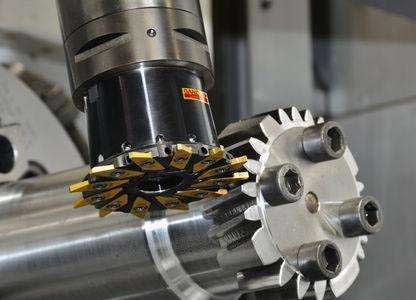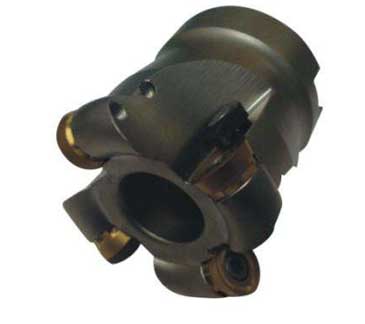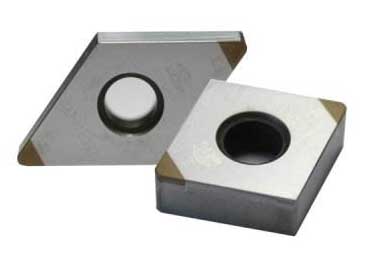What are the Conditions for Precision Titanium Alloy Milling & Turning?
Round insert milling cutters are suitable for milling titanium because their leading angles can be varied as appropriate. As long as these milling cutters are equipped with special inserts and the correct cutting parameters are applied, stability and overall performance are generally improved. Each knife is set to be the minimum amount of feed, which is crucial.

---Titanium alloy milling requires suitable conditions
Titanium processing is not only more demanding but also more limited than most other metal materials. This is because the metallurgical properties and material properties of titanium alloys can have a serious impact on the cutting action and the material itself. However, if you choose the right tool and use it correctly, and optimize the machine and configuration to the best conditions for titanium machining, you can meet these requirements and achieve satisfactory performance and perfect results. Many of the problems encountered in traditional titanium metal processing are not inevitable, as long as the effects of titanium properties on the processing process are overcome, success can be achieved.
The various properties of titanium make it a powerful material for parts, but many of its properties also affect its machinability. Titanium has an excellent strength-to-weight ratio, which is usually only 60% of the density of steel. Titanium has a lower modulus of elasticity than steel, so the texture is harder and the deflection is better. Titanium is also superior to stainless steel in corrosion resistance and has low thermal conductivity. These properties mean that titanium will produce higher and more concentrated cutting forces during processing. It is prone to vibrations that cause tremors during cutting; Moreover, it is also easy to react with the cutting tool material during cutting, thereby aggravating tool crater wear. In addition, its thermal conductivity is poor, and since the heat is mainly concentrated in the cutting zone, the tool for processing titanium must have high heat hardness.
Stability is the key to success
Some machine shops have found that titanium is difficult to process efficiently, but this view does not represent the trend of modern processing methods and tools. Part of the difficulty is due to the fact that titanium processing is an emerging process and lacks experience to learn from. In addition, the difficulties often associated with the operator's experience and expectations, in particular, some people have become accustomed to processing the material in cast iron or low-alloy steel, processing requirements of these materials is generally low. In contrast, machining titanium seems to be more difficult because the same tool and the same rate cannot be used in machining and the tool life is different. Titanium processing is still more difficult than some stainless steels. We can certainly say that the processing of titanium must take different cutting speeds and feeds as well as certain precautions. In fact, titanium is also a completely directly processable material compared to most materials. As long as the titanium workpiece is stable, the clamping is firm, the machine tool is selected correctly, the power is right, and the working condition is good. And with an ISO 50 spindle with a short tool overhang, all problems are solved – as long as the cutting tool is correct.
However, in actual milling, the conditions required for titanium metal processing are not always satisfactory, because ideal stability conditions are not always available. In addition, many titanium parts are complex in shape and may contain many fine or deep cavities, thin walls, bevels, and thin brackets. To successfully machine such parts, large overhangs and small diameter tools are required, which can affect tool stability. When processing of titanium metal, tend to be more prone to potential stability problems.
 Vibration and heat must be considered
Vibration and heat must be considered
The non-ideal environment also includes other factors, one of which is that most control machines are currently equipped with an IS0 40 spindle. If the machine is used with high strength, it is impossible to maintain the new knife state for a long time. In addition, if the part structure is complicated, it is usually not easy to clamp effectively. Of course, the challenge is not limited to this. The cutting process must sometimes be used for full slot milling, side cutting or contour milling. All of these are possible (but not necessarily) to generate vibrations and to form poor cutting conditions. It is important to always pay attention to improving stability when setting up the machine to avoid vibration trends. Vibration can cause blade breakage, blade damage and unpredictable and inconsistent results. An improved measure is the use of multi-stage clamping, the part closer to the spindle to help offset the vibrations.
Since titanium retains its hardness and strength at high temperatures, and thus the cutting edge will experience high forces and stresses. Coupled with the high heat generated in the cutting zone, it means that work hardening is likely to occur, which causes some problems, especially for subsequent cutting operations. Therefore, choosing the best indexable insert grades and geometries is the key to success. Past history has proven that fine-grained non-coated insert grades are ideal for titanium processing; Today, blade grades with PVD titanium coatings can greatly improve performance.
Accuracy, conditions and correct cutting parameters
The accuracy of the tool's runout in the axial and radial directions is also important. For example, if the blade is not properly installed in the milling cutter, the cutting edge around the milling cutter can be quickly damaged. When cutting titanium, other factors, such as poor tool manufacturing tolerances, wear and tool damage, defective or poor tool holders, machine tool spindle wear, etc., can greatly affect tool life. Observations show that 80% of all cases of poor processing performance are caused by these factors. Although most people prefer to use a positive rake cutter, in fact a slightly negative rake cutter can remove material with a higher feed and feeds up to 0.5 mm per tooth. But this also means that the best stability must be maintained, that is, the machine should be very strong and the clamping should be extremely stable.
In addition to plunge milling (preferably using round inserts), the 90 main declination should be avoided as much as possible, which usually helps to improve stability and overall performance, especially when used under shallow depths. When performing deep cavity milling, a recommended approach is to use a tool with a variable length through the tool adapter instead of using a single tool of a single length throughout the process.
Adjusting the cutting parameters to overcome the vibration caused by reducing the feed per tooth is a traditional solution, but this method is not appropriate because it can have a catastrophic effect on tool life and cutting performance. Indexable inserts require a certain amount of cutting edge to be rounded to increase cutting edge strength and achieve better coating adhesion.
When milling titanium, the tool is required to work with at least a minimum feed rate - typically 0.1 mm per tooth. If the tendency to vibrate is thrown, the problem of blade damage or shortened tool life will be inevitable. Possible solutions include accurately calculating the feed per tooth and making sure it is at least 0.1 mm.
In addition, the spindle speed can be reduced to achieve the initial feed rate. If the minimum feed per tooth is used and the spindle speed is incorrect, the tool life can be as high as 95%. Reducing the spindle speed usually increases tool life.
Once stable conditions are established, the spindle speed and feed rate can be increased accordingly for optimum performance. Another option is to remove some of the blades from the milling cutter or choose a milling cutter with fewer blades.


---Titanium alloy milling requires suitable conditions
Titanium processing is not only more demanding but also more limited than most other metal materials. This is because the metallurgical properties and material properties of titanium alloys can have a serious impact on the cutting action and the material itself. However, if you choose the right tool and use it correctly, and optimize the machine and configuration to the best conditions for titanium machining, you can meet these requirements and achieve satisfactory performance and perfect results. Many of the problems encountered in traditional titanium metal processing are not inevitable, as long as the effects of titanium properties on the processing process are overcome, success can be achieved.
The various properties of titanium make it a powerful material for parts, but many of its properties also affect its machinability. Titanium has an excellent strength-to-weight ratio, which is usually only 60% of the density of steel. Titanium has a lower modulus of elasticity than steel, so the texture is harder and the deflection is better. Titanium is also superior to stainless steel in corrosion resistance and has low thermal conductivity. These properties mean that titanium will produce higher and more concentrated cutting forces during processing. It is prone to vibrations that cause tremors during cutting; Moreover, it is also easy to react with the cutting tool material during cutting, thereby aggravating tool crater wear. In addition, its thermal conductivity is poor, and since the heat is mainly concentrated in the cutting zone, the tool for processing titanium must have high heat hardness.
Stability is the key to success
Some machine shops have found that titanium is difficult to process efficiently, but this view does not represent the trend of modern processing methods and tools. Part of the difficulty is due to the fact that titanium processing is an emerging process and lacks experience to learn from. In addition, the difficulties often associated with the operator's experience and expectations, in particular, some people have become accustomed to processing the material in cast iron or low-alloy steel, processing requirements of these materials is generally low. In contrast, machining titanium seems to be more difficult because the same tool and the same rate cannot be used in machining and the tool life is different. Titanium processing is still more difficult than some stainless steels. We can certainly say that the processing of titanium must take different cutting speeds and feeds as well as certain precautions. In fact, titanium is also a completely directly processable material compared to most materials. As long as the titanium workpiece is stable, the clamping is firm, the machine tool is selected correctly, the power is right, and the working condition is good. And with an ISO 50 spindle with a short tool overhang, all problems are solved – as long as the cutting tool is correct.
However, in actual milling, the conditions required for titanium metal processing are not always satisfactory, because ideal stability conditions are not always available. In addition, many titanium parts are complex in shape and may contain many fine or deep cavities, thin walls, bevels, and thin brackets. To successfully machine such parts, large overhangs and small diameter tools are required, which can affect tool stability. When processing of titanium metal, tend to be more prone to potential stability problems.

The non-ideal environment also includes other factors, one of which is that most control machines are currently equipped with an IS0 40 spindle. If the machine is used with high strength, it is impossible to maintain the new knife state for a long time. In addition, if the part structure is complicated, it is usually not easy to clamp effectively. Of course, the challenge is not limited to this. The cutting process must sometimes be used for full slot milling, side cutting or contour milling. All of these are possible (but not necessarily) to generate vibrations and to form poor cutting conditions. It is important to always pay attention to improving stability when setting up the machine to avoid vibration trends. Vibration can cause blade breakage, blade damage and unpredictable and inconsistent results. An improved measure is the use of multi-stage clamping, the part closer to the spindle to help offset the vibrations.
Since titanium retains its hardness and strength at high temperatures, and thus the cutting edge will experience high forces and stresses. Coupled with the high heat generated in the cutting zone, it means that work hardening is likely to occur, which causes some problems, especially for subsequent cutting operations. Therefore, choosing the best indexable insert grades and geometries is the key to success. Past history has proven that fine-grained non-coated insert grades are ideal for titanium processing; Today, blade grades with PVD titanium coatings can greatly improve performance.
Accuracy, conditions and correct cutting parameters
The accuracy of the tool's runout in the axial and radial directions is also important. For example, if the blade is not properly installed in the milling cutter, the cutting edge around the milling cutter can be quickly damaged. When cutting titanium, other factors, such as poor tool manufacturing tolerances, wear and tool damage, defective or poor tool holders, machine tool spindle wear, etc., can greatly affect tool life. Observations show that 80% of all cases of poor processing performance are caused by these factors. Although most people prefer to use a positive rake cutter, in fact a slightly negative rake cutter can remove material with a higher feed and feeds up to 0.5 mm per tooth. But this also means that the best stability must be maintained, that is, the machine should be very strong and the clamping should be extremely stable.
In addition to plunge milling (preferably using round inserts), the 90 main declination should be avoided as much as possible, which usually helps to improve stability and overall performance, especially when used under shallow depths. When performing deep cavity milling, a recommended approach is to use a tool with a variable length through the tool adapter instead of using a single tool of a single length throughout the process.
Adjusting the cutting parameters to overcome the vibration caused by reducing the feed per tooth is a traditional solution, but this method is not appropriate because it can have a catastrophic effect on tool life and cutting performance. Indexable inserts require a certain amount of cutting edge to be rounded to increase cutting edge strength and achieve better coating adhesion.
When milling titanium, the tool is required to work with at least a minimum feed rate - typically 0.1 mm per tooth. If the tendency to vibrate is thrown, the problem of blade damage or shortened tool life will be inevitable. Possible solutions include accurately calculating the feed per tooth and making sure it is at least 0.1 mm.
In addition, the spindle speed can be reduced to achieve the initial feed rate. If the minimum feed per tooth is used and the spindle speed is incorrect, the tool life can be as high as 95%. Reducing the spindle speed usually increases tool life.
Once stable conditions are established, the spindle speed and feed rate can be increased accordingly for optimum performance. Another option is to remove some of the blades from the milling cutter or choose a milling cutter with fewer blades.






